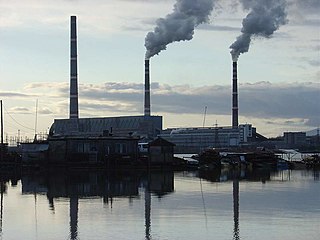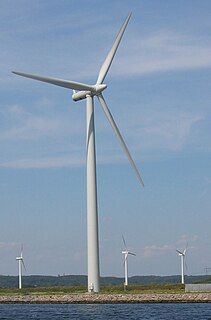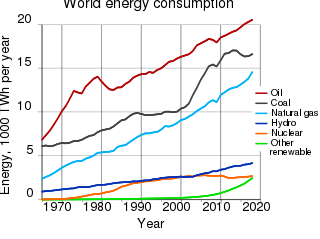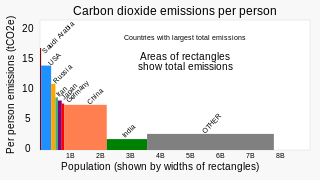Related Research Articles

A carbon tax is a tax levied on the carbon emissions required to produce goods and services. Carbon taxes are intended to make visible the "hidden" social costs of carbon emissions, which are otherwise felt only in indirect ways like more severe weather events. In this way, they are designed to reduce carbon dioxide (CO
2) emissions by increasing prices of the fossil fuels that emit them when burned. This both decreases demand for such goods and services that produce high emissions and incentivizes efforts to make them less carbon-intensive. In its simplest form, a carbon tax covers only CO2 emissions; however, they can also cover other greenhouse gases, such as methane or nitrous oxide, by taxing such emissions based on their CO2-equivalent global warming potential. When a hydrocarbon fuel such as coal, petroleum, or natural gas is burned, most or all of its carbon is converted to CO
2. Greenhouse gas emissions cause climate change, which damages the environment and human health. This negative externality can be reduced by taxing carbon content at any point in the product cycle. Carbon taxes are thus a type of Pigovian tax.

There is a strong scientific consensus that the Earth is warming and that this warming is mainly caused by human activities. This consensus is supported by various studies of scientists' opinions and by position statements of scientific organizations, many of which explicitly agree with the Intergovernmental Panel on Climate Change (IPCC) synthesis reports.
An emission intensity is the emission rate of a given pollutant relative to the intensity of a specific activity, or an industrial production process; for example grams of carbon dioxide released per megajoule of energy produced, or the ratio of greenhouse gas emissions produced to gross domestic product (GDP). Emission intensities are used to derive estimates of air pollutant or greenhouse gas emissions based on the amount of fuel combusted, the number of animals in animal husbandry, on industrial production levels, distances traveled or similar activity data. Emission intensities may also be used to compare the environmental impact of different fuels or activities. In some case the related terms emission factor and carbon intensity are used interchangeably. The jargon used can be different, for different fields/industrial sectors; normally the term "carbon" excludes other pollutants, such as particulate emissions. One commonly used figure is carbon intensity per kilowatt-hour (CIPK), which is used to compare emissions from different sources of electrical power.

A carbon footprint is the total greenhouse gas (GHG) emissions caused by an individual, event, organization, service, place or product, expressed as carbon dioxide equivalent (CO2e). Greenhouse gases, including the carbon-containing gases carbon dioxide and methane, can be emitted through the burning of fossil fuels, land clearance and the production and consumption of food, manufactured goods, materials, wood, roads, buildings, transportation and other services.

A carbon offset is a reduction or removal of emissions of carbon dioxide or other greenhouse gases made in order to compensate for emissions made elsewhere. Offsets are measured in tonnes of carbon dioxide-equivalent (CO2e). One ton of carbon offset represents the reduction or removal of one ton of carbon dioxide or its equivalent in other greenhouse gases. Offsets are viewed as an important policy tool to maintain stable economies and to improve sustainability. One of the hidden dangers of climate change policy is unequal prices of carbon in the economy, which can cause economic collateral damage if production flows to regions or industries that have a lower price of carbon—unless carbon can be purchased from that area, which offsets effectively permit, equalizing the price.

Contemporary climate change includes both global warming and its impacts on Earth's weather patterns. There have been previous periods of climate change, but the current changes are distinctly more rapid and not due to natural causes. Instead, they are caused by the emission of greenhouse gases, mostly carbon dioxide and methane. Burning fossil fuels for energy use creates most of these emissions. Certain agricultural practices, industrial processes, and forest loss are additional sources. Greenhouse gases are transparent to sunlight, allowing it through to heat the Earth's surface. When the Earth emits that heat as infrared radiation the gases absorb it, trapping the heat near the Earth's surface. As the planet heats up it causes changes like the loss of sunlight-reflecting snow cover, amplifying global warming.
Massachusetts v. Environmental Protection Agency, 549 U.S. 497 (2007), is a 5–4 U.S. Supreme Court case in which twelve states and several cities of the United States, represented by James Milkey, brought suit against the Environmental Protection Agency (EPA) to force that federal agency to regulate carbon dioxide and other greenhouse gases (GHGs) as pollutants.
Greenhouse gas inventories are emission inventories of greenhouse gas emissions that are developed for a variety of reasons. Scientists use inventories of natural and anthropogenic (human-caused) emissions as tools when developing atmospheric models. Policy makers use inventories to develop strategies and policies for emissions reductions and to track the progress of those policies. Regulatory agencies and corporations also rely on inventories to establish compliance records with allowable emission rates. Businesses, the public, and other interest groups use inventories to better understand the sources and trends in emissions.

Greenhouse gas emissions from human activities strengthen the greenhouse effect, causing climate change. Most is carbon dioxide from burning fossil fuels: coal, oil, and natural gas. The largest emitters include coal in China and large oil and gas companies, many state-owned by OPEC and Russia. Human-caused emissions have increased atmospheric carbon dioxide by about 50% over pre-industrial levels. The growing levels of emissions have varied, but it was consistent among all greenhouse gases. Emissions in the 2010s averaged 56 billion tons a year, higher than ever before.

The United States produced 6.6 billion metric tons of carbon dioxide equivalent greenhouse gas (GHG) emissions in 2019, the second largest in the world after greenhouse gas emissions by China and among the countries with the highest greenhouse gas emissions per person. In 2019 China is estimated to have emitted 27% of world GHG, followed by the United States with 11%, then India with 6.6%. In total the United States has emitted a quarter of world GHG, more than any other country. Annual emissions are over 15 tonnes per person and, amongst the top eight emitters, is the highest country by greenhouse gas emissions per person. Because coal-fired power stations are gradually shutting down, in the 2010s emissions from electricity generation fell to second place behind transportation which is now the largest single source. In 2019, 29% of the GHG emissions of the United States were from transportation, 25% from electricity, 23% from industry, 13% from commercial and residential buildings and 10% from agriculture. These greenhouse gas emissions are contributing to climate change in the United States as well as worldwide.
Kenneth Caldeira is an American atmospheric scientist. His areas of research include ocean acidification, climate effects of trees, intentional climate modification, interactions in the global carbon cycle/climate system, and sustainable energy.

Carbon dioxide removal (CDR), also known as negative CO2 emissions, is a process in which carbon dioxide gas is removed from the atmosphere and sequestered for long periods of time. Similarly, greenhouse gas removal (GGR) or negative greenhouse gas emissions is the removal of greenhouse gases (GHGs) from the atmosphere by deliberate human activities, i.e., in addition to the removal that would occur via natural carbon cycle or atmospheric chemistry processes. In the context of net zero greenhouse gas emissions targets, CDR is increasingly integrated into climate policy, as a new element of mitigation strategies. CDR and GGR methods are also known as negative emissions technologies (NET), and may be cheaper than preventing some agricultural greenhouse gas emissions.

Mark Zachary Jacobson is a professor of civil and environmental engineering at Stanford University and director of its Atmosphere/Energy Program. He is also a co-founder of the non-profit, Solutions Project.

A greenhouse gas (GHG or GhG) is a gas that absorbs and emits radiant energy within the thermal infrared range, causing the greenhouse effect. The primary greenhouse gases in Earth's atmosphere are water vapor (H2O), carbon dioxide (CO2), methane (CH4), nitrous oxide (N2O), and ozone (O3). Without greenhouse gases, the average temperature of Earth's surface would be about −18 °C (0 °F), rather than the present average of 15 °C (59 °F). The atmospheres of Venus, Mars and Titan also contain greenhouse gases.

The environmental impact of the energy industry is significant, as energy and natural resource consumption are closely related. Producing, transporting, or consuming energy all have an environmental impact. Energy has been harnessed by human beings for millennia. Initially it was with the use of fire for light, heat, cooking and for safety, and its use can be traced back at least 1.9 million years. In recent years there has been a trend towards the increased commercialization of various renewable energy sources. Scientific consensus on some of the main human activities that contribute to global warming are considered to be increasing concentrations of greenhouse gases, causing a warming effect, global changes to land surface, such as deforestation, for a warming effect, increasing concentrations of aerosols, mainly for a cooling effect.

The environmental effects of shipping include air pollution, water pollution, acoustic, and oil pollution. Ships are responsible for more than 18 percent of some air pollutants.

The environmental impact of the petroleum industry is extensive and expansive due to petroleum having many uses. Crude oil and natural gas are primary energy and raw material sources that enable numerous aspects of modern daily life and the world economy. Their supply has grown quickly over the last 150 years to meet the demands of rapidly increasing human population, creativity, and consumerism.

Carbon-neutral fuel is fuel which produces no net-greenhouse gas emissions or carbon footprint. In practice, this usually means fuels that are made using carbon dioxide (CO2) as a feedstock. Proposed carbon-neutral fuels can broadly be grouped into synthetic fuels, which are made by chemically hydrogenating carbon dioxide, and biofuels, which are produced using natural CO2-consuming processes like photosynthesis.

Greenhouse gas emissions by China are the largest of any country in the world both in production and consumption terms, and stem mainly from coal burning in China, including coal-fired power stations, coal mining, and blast furnaces producing iron and steel. When measuring production-based emissions, China emitted over 14 gigatonnes (Gt) CO2eq of greenhouse gases in 2019, 27% of the world total. When measuring in consumption-based terms, which adds emissions associated with imported goods and extracts those associated with exported goods, China accounts for 13 gigatonnes (Gt) or 25% of global emissions.

An emissions target or greenhouse gas emissions reduction target is the central policy instrument of international greenhouse gas emissions reduction politics and a key pillar of climate policy. They typically include heavy consideration of emissions budgets, which are calculated using rate of warming per standard emission of carbon dioxide, a historic baseline temperature, a desired level of confidence and a target global average temperature to stay below.
References
- ↑ Departmental directory, Civil and Environmental Engineering, UCI
- ↑ "Publons profile"
- ↑ "Steve Davis Curriculum Vitae". ess.uci.edu. Retrieved 10 June 2016.
- ↑ "Steve Davis Curriculum Vitae". Retrieved 14 March 2014.
- ↑ "Caldeira Lab". Retrieved 27 November 2012.
- ↑ Broder, John. "Counting 'Outsourced' Greenhouse Gas Emissions", New York Times , 8 March 2010. Retrieved 20 April 2012.
- ↑ "Trading Down", The Economist , 8 March 2010. Retrieved 20 April 2012.
- ↑ "China Exports Pollution to U.S., Study Finds", New York Times , 20 January 2014. Retrieved 10 June 2016.
- ↑ Walsh, Bryan. "Energy: Reducing CO2 Emissions Will Be Harder Than You Think", TIME Magazine , 9 September 2010. Retrieved 20 April 2012.
- ↑ Main, Douglas. "We've Been Counting Carbon Dioxide Emissions All Wrong", TIME Magazine , 26 August 2014. Retrieved 10 June 2016.
- ↑ Revkin, Andy. "Accounting for the Expanding Carbon Shadow From Coal-Burning Plants", Dot Earth , 28 August 2014. Retrieved 10 June 2016.
- ↑ Netborn, Deborah. "Why an economic recession could be good for the planet", Los Angeles Times , 22 July 2015. Retrieved 10 June 2016.
- ↑ Buckley, Chris. "China's Carbon Dioxide Emissions May Have Been Overstated by More Than 10%", New York Times , 19 August 2015. Retrieved 10 June 2016.
- ↑ Harris, Richard. "For Developing Nations, Exports Boost CO2 Emissions", NPR , 8 March 2010. Retrieved 20 April 2012.
- ↑ Coghlan, Andy. "Intensive farming 'massively slowed' global warming", New Scientist , 14 June 2010. Retrieved 20 April 2012.
- ↑ Cozzarelli Prize
- ↑ O'Brien, Chris. "Beer and Climate Change", Beer Activist blog , 1 July 2008. Retrieved 20 April 2012.
- ↑ Near Zero. Retrieved 2 July 2018.
- ↑ ERL Editorial Board. Retrieved 10 June 2016.